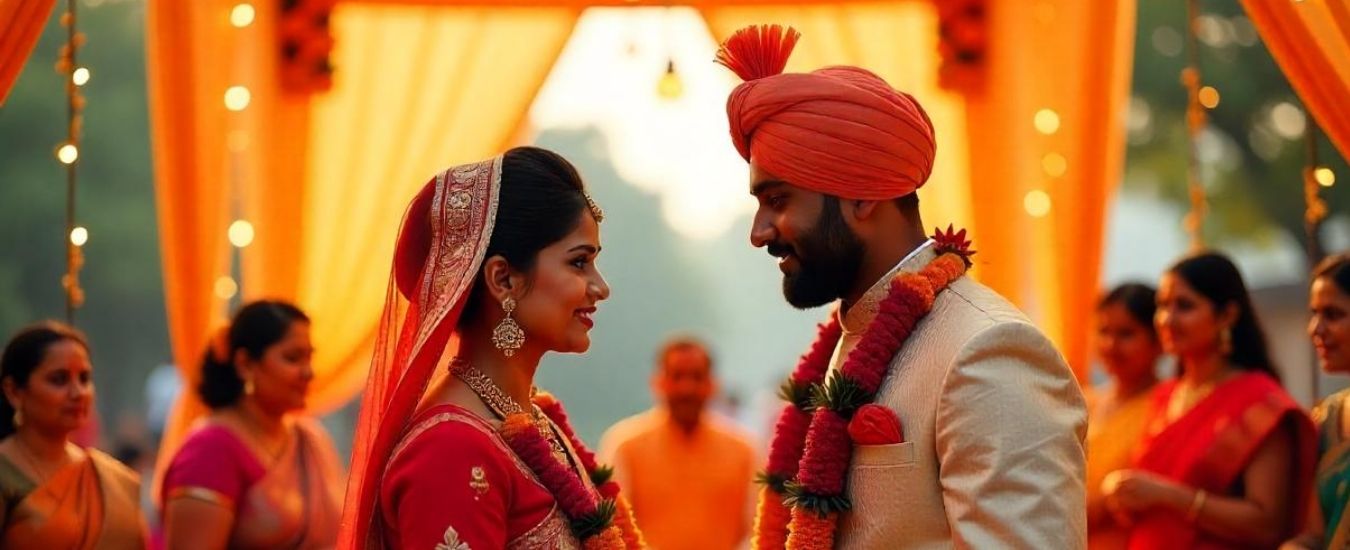A Gujarati wedding is nothing short of a cinematic celebration—vibrant, spiritual, and deeply rooted in tradition. It’s not just a union of two hearts but of two families, lineages, and sacred beliefs, brought together under the blessings of Agni Saakshi (fire as witness).
A Gujarati wedding is a perfect blend of sacred traditions, emotional rituals, festive energy, and modern expression. Whether you’re attending or organizing one, remember—it’s not just a wedding; it’s a spiritual journey infused with culture and joy.
Let’s explore with Aagrah Banquet, this rich journey with all its rituals, attire, legalities, and modern twists.
Pre-Wedding Rituals
Chandlo Matli
The celebrations begin with this Vivah Sanskar ritual, where the bride’s father places a chandlo (red mark) on the groom’s forehead and gifts him a matli (Pot) filled with sweets and clothes, symbolizing official approval.
Gol Dhana
A Gujarati-style engagement with jaggery and coriander seeds, symbolizing sweetness and freshness. Families exchange Lagna Patrika (wedding letter) and gifts. Rings may be exchanged, and Kundali matching is often confirmed.
Mehendi (Henna) Ceremony
A blend of art and aura cleansing, where the bride’s hands and feet are adorned with henna, and the groom’s name is hidden. According to tradition, the darker the henna, the deeper the love.
Sangeet Sandhya
A night of folk dances like Garba and Raas, where both families dance and celebrate. This is a blend of Gujarati tradition and Bollywood-style glamour.
Mameru Ceremony
The bride’s maternal uncle (mama) brings jewellery, sarees, and sweets, symbolizing the strength of maternal ties. Bajubandh, Kamarbandh, and green bangles often form part of the gifted jewellery.
Gujarati Wedding Eve Rituals
Mandap Mahurat
Performed during an auspicious muhurat with Swastik symbols and Ganesha Poojan, this ceremony is about seeking blessings before constructing the mandap—the sacred wedding altar.
A spiritual cleansing performed through Vedic havan, invoking peace and ancestral blessings.
Pithi/Haldi Ceremony
A Haldi (turmeric) paste is applied to purify the bride and groom and provide that golden glow. Expect fun, laughter, and lots of yellow!
Wedding Day Rituals
Baraat
The groom arrives on a horse or luxury car, dancing to dhol beats. He wears a safa with brooch, mojaris, and often a pearl necklace.
Ponkhvu
The bride’s mother greets the groom with aarti and jokingly pulls his nose to remind him to stay grounded!
Jaimala
A playful garland exchange between the couple often turned into a fun height battle with friends.
Antahpat and Kanya Daan
The bride’s father gives away his daughter in the Kanyadaan ritual, symbolizing trust. Before this, a cloth curtain (Antahpat) separates the couple until the mantras begin.
Hasta Milap and Mangal Pheras
Their garments are tied together, and they take four Mangal Pheras around the sacred fire—representing Dharma, Artha, Kama, and Moksha.
Saptapadi
Seven sacred steps with promises of loyalty, respect, and companionship. It forms the spiritual foundation of married life.
Sindoor and Mangalsutra
The groom applies sindoor (vermilion) and ties the Mangalsutra—symbols of eternal commitment.
Kansar Bhakshan
The couple shares their first sweet, kansar, representing love and mutual care.
Post-Wedding Rituals
Vidaai
A bittersweet goodbye as the bride departs from her parental home amid tears and blessings.
Ghar Ni Laxmi
The bride arrives at her new home and kicks a rice pot to symbolize prosperity entering the house.
Aeki-Beki
A playful ritual where the couple searches for a ring in a bowl of milk and rose petals—the winner is said to rule the relationship!
Wedding Attire and Jewelry
For the Bride
Typically, wears a Panetar during the ceremony and changes into a Gharchola afterwards. Nathni (nose ring), mang tikka, bangles, and gold or pearl necklaces complete the bridal look.
For the Groom
Wears a dhoti-kurta or sherwani with bandhani dupatta, mojaris, and an embellished safa. Modern grooms may also wear custom sherwanis with eco-friendly fabrics.
Food and Festivities
Gujarati weddings are a paradise for vegetarians. The wedding thali includes dal, bhaat, shaak, puri, sweets like basundi, shrikhand, and mohanthal. Don’t miss the chaat counters and paan stations!
Modern Gujarati Weddings
Couples now opt for destination weddings, hire wedding planners, use drone photography, and even curate eco-friendly celebrations with sustainable decor and plantable invites.
FAQs
What is the significance of the Mangal Pheras in a Gujarati wedding?
In Gujarati tradition, four pheras are taken around the sacred fire, each representing a life vow: duty, prosperity, love, and spiritual liberation.
Why do Gujaratis perform the Gol Dhana ceremony?
It’s a formal engagement where families exchange gifts and sweets, symbolizing a sweet beginning and mutual respect.
What is Aeki-Beki, and why is it played?
It’s a fun post-wedding game that helps the bride and groom bond. Whoever finds the ring first is believed to be dominant in the marriage!
What is the difference between Panetar and Gharchola?
Panetar is worn during the wedding, gifted by the maternal uncle, while Gharchola is gifted by the in-laws and worn after the wedding.
Are Gujarati weddings always vegetarian?
Traditionally, yes. Most Gujarati weddings are strictly vegetarian and alcohol-free, although modern ones may vary depending on the family’s preferences.
